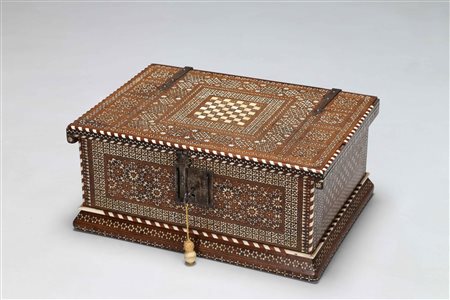 Capitolium Art - Via Carlo Cattaneo 55, 25121 Brescia
Capitolium Art - Via Carlo Cattaneo 55, 25121 Brescia
ASTA 193 - FINE CHINESE, ASIAN & ISLAMIC WORKS OF ART 3A SESSIONE
venerdì 11 dicembre 2015 ore 15:30 (UTC +01:00)
Arte Islamica Baule Nasride o Mudejar in legno di noce ed intarsi in avorio...
Arte Islamica Baule Nasride o Mudejar in legno di noce ed intarsi in avorio
Spagna Meridionale, XV - XVI secolo. . Cm 52,00 x 23,00 x 37,00. Baule rettangolare, con coperchio incernierato, decorato secondo una tecnica denominata certosina, dalla meticolosità dei lavori svolti alla Certosa di Pavia, ovvero intarsiato a micro mosaico d'avorio ed ebano a formare i tradizionali decori geometrici a stella su tutti i lati, compresa la superficie interna del coperchio, caratterizzata dallo stesso motivo entro riserve circolari. Il motivo decorativo è tipico della produzione Nasride e si ritrova comunemente anche su altri media quali tappeti e soprattutto tessuti.
L'interno è provvisto di due lunghi scompartimenti rettangolari con coperchio probabilmente atti ad contenere strumenti per la scrittura, mentre sopra il coperchio c'è una scacchiera quadrata ad indicazione del fatto che il baule fosse utilizzato anche come tavolo da gioco
Completo di chiave
Un oggetto simile è passato in asta da Sotheby's Londra lo scorso 7 ottobre (lotto 323) ed un altro è conservato al Victoria and Albert Museum ( museum number 7224-1860).
Ottime condizioni di conservazione nonostante qualche caduta e mancanza.
Arte Islamica A Nasrid or Mudejar walnut ivory inlaid chest
Southern Spain, 15th - 16th century . . Cm 52,00 x 23,00 x 37,00. This rectangular chest with hinged cover is embellished with a technique called "certosina" (from the works made at Certosa di Pavia): the decoration is inlaid with micromosaic of ivory and ebony, forming traditional geometric patterns which cover every side of the chest, included the inside of the cover. This decoration is tipical of the Nasirid school and is commonly found in other artworks like rugs and fabrics. The inside of the chest has two long compartments with their own lids, and writing instruments were probably kept inside them. A square chessboard is painted on the cover of the chest, and this means that the object was also used as game table. Key is included. A similar object was auctioned by Sotheby's London last 7th October (lot 323), and another one is located in Victoria and Albert Museum (museum number 7224-1860). The chest is in excellent conditions.







